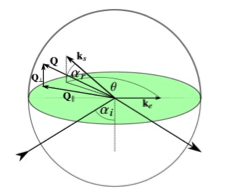Evanescent wave dynamic light scattering differs in two aspects from conventional dynamic light scattering.
- An evanescent wave with a typical penetration depth of some hundred nanometers is used as the illumination source which is created by total reflection of a laser beam off the the plane interface between a glass body and the suspension which is to be investigated. Therefore scattering information is collected only from a very thin sample volume segment at the reflecting interface.
- Exploiting the symmetry break caused by the interface, the scattering vector can be decomposed into components parallel and normal to the interface. By this it is possible to distinguish between particle motion parallel and normal to the wall.
The EWDLS set up is a home-built instrument based on a triple axis diffractometer by Huber Diffraktionstechnik, Rimsting, Germany, as shown in the image below.
The setup is equipped with a frequency doubled Nd/Yag Laser (Excelsior; Spectra Physics) with a vacuum wavelength of 532 nm and a nominal power output of 300 mW as a light source. Scattered light is collected with an optical enhancer system by ALV Lasververtriebsgesellschaft, Langen, Germany, which is connected to two avalanche photo diodes by Perkin Elmer via an ALV fiber splitter. The TTL signals of the diodes are cross-correlated using an ALV-6000 multiple tau correlator.
The scattering geometry and the definition of the scattering vector and its component parallel and normal to the interface are shown in the sketch below. The evanescent wave has a wave vector ke pointing in the direction of the reflected beam’s projection onto the reflecting interface. The scattering vector is given Q=ks–ke, where the scattered light wave vector, ks, is defined by the two angles q and ar which describe the position of the detecting unit.
The sample cell (custom-made by Hellma GmbH, Muellheim, Germany) consists of a hemispherical lens as the bottom part, made of SF10 glass, with an index of refraction n1 = 1.736 at l=532 nm. The particle suspension is contained in a hemispherical dome sitting on top of the lens. The primary beam is reflected off the interface between the glass and the solution, which is considered to be a flat wall, by that creating an evanescent wave in the solution which is used as the illumination for the scattering experiment.
 |
 |
 |
Left: Photograph of the EWDLS setup; middle: definition of the scattering vector components; right: principle of the creation of an evanescent wave, by total reflection (not drawn to scale)
